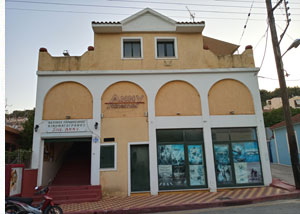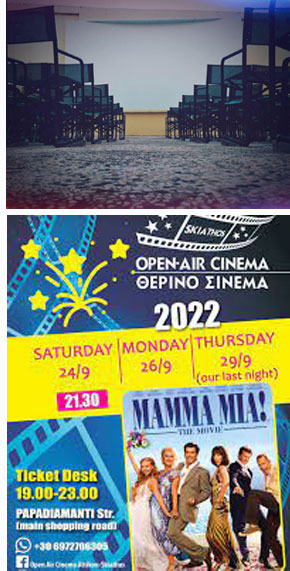|
|
GREEN CINEMAS
|
Green cinemas in France: best experiences, financial support, information tools for cinema exhibitors |
This is an extract of the constantly updated map “Green cinemas in Europe” that you can consult here
France: the label of the CNC
by Elisabetta Brunella

 Around 300 French exhibition businesses took part in the online survey launched by CNC - Centre National du Cinéma et de l'Image animée - on the sustainability of the cinema industry. Around 300 French exhibition businesses took part in the online survey launched by CNC - Centre National du Cinéma et de l'Image animée - on the sustainability of the cinema industry.
The practices already taken on board or the intention to put them into practice shortly, the difficulties most feared, the role movie theatres can play in society in favour of the environmental transition: these are the areas the survey wished to shed light on.
The results show that 69% of the exhibitors interviewed have taken initiatives over the past few years to reduce the cinema's carbon footprint: waste sorting is the most widespread measure, followed by limiting printed material and by the use of biodegradable cleaning products. 46% of those who took part in the survey expressed their determination to undertake further action in favour of the environment over the next few years, whilst the obstacles were identified as deriving mostly from lack of financial resources - quoted by 77% of respondents - the time to be devoted to these activities and the management of unforeseen events (61%), as well as the scarcity of information about the impact of movie theatres' practices on the environment (50%).
But CNC was not satisfied with merely reporting these factors: and so they commissioned a specialized organization to measure movie theatres' energy consumption and to take a snapshot of the problems linked to waste management. The objective was to define an efficient energy strategy that could be adopted by exhibition companies.
After analysing the energy balance of large buildings such as schools and universities, sports centres, residential or administrative complexes, Eneor, an environmental consultancy and engineering company, founded in France in 2011, thus examined fourteen cinemas with features representing the range of exhibition in France.
As regards the type of ownership involved, nine were independent companies and five were circuits, belonging to two associations, two public companies and ten private entrepreneurs.
As for the type of structure, three were single-screen, four multiplexes and seven multi-screen complexes situated in different areas of the country and built over a time span ranging from 1950 to 2019.
Great disparity emerged in their energy consumption with annual costs per square metre ranging from a little over 5 euros to more than 35. What weighed most were the areas of heating/ventilation/air conditioning (68.8% of costs) and projection/server/audio. Whilst in the latter area just one action is suggested - replacing obsolete projectors with laser ones - in the former around thirty different measures are suggested, starting from the use of renewable energy sources. Concerning waste management, the solutions are decidedly less expensive and easier to put into practice, beginning with the training of cleaning staff, improved management of space and better tools for succeeding in communicating with spectators, involving them and raising their awareness.
These are measures that should nevertheless be adopted quite urgently, in view of the fact that by law all buildings in the third sector with a surface area of over 1,000 square metres (among which there are about 1,000 cinema sites) must reduce their energy consumption by 40% compared to 2010 no later than 2030, and 60% by 2050.
Time is scarce - even if we only consider how demanding the investments are for the transition to laser projection technology and the fact that in France there are over 6,000 screens - yet there is no lack of eager beavers who are already projected towards the future.
Examples come from Rumilly, in Haute Savoie, where the complex "Les lumières de la ville", inaugurated in 2017, was conceived as a zero-impact building, and the cinema Loft in Châtellerault. This cutting-edge, seven-screen complex uses exclusively energy from renewable sources (a mix of wind, sun and hydro-electric power), sourcing it from a specialised purchasing group. Every year a calculation is made of its environmental impact and this is compensated by planting new trees through the organization reforestACTION.
In Marseilles the Artplexe Canebière, designed by the archistar Jean-Michel Wilmotte, has installed laser projectors only, whilst the Ciné Manivel has embraced the "zero kilometre" philosophy for its Ciné Café, which obtains its supplies from local producers and guarantees vegetarian and vegan dishes on its menu.
In short, there is no lack of inspiration here for exhibitors who have expressed their determination and commitment to making a better planet ...
This article was published in issue no. 189 of Cinema & Video Int'l, the MEDIA Salles media partner. |
|
 |
FROM OUR SPECIAL CORRESPONDENT... |
Open-air cinemas in Greece

 Ten million or so spectators and a total of just under 500 screens: these are the basic figures for Greece, at least up until Covid which, here too, as in the rest of the world, upset habitual cinema-going habits. The Greek market, however, has one special feature that makes it an almost unique case on the international scenario: the high percentage of open-air cinemas which, in the summer season, managed to attract 60% or more of audiences in “normal” times. In addition, the 160 or so screens “beneath the stars” - which represent more or less a third of the total - are located not only in the Capital and at Thessaloniki, the cities where the highest numbers of spectators are to be found annually, but also in seaside locations and in particular in the islands, thus succeeding in attracting cinema-loving tourists, as well. In this issue, we take a look at the open-air theatres, with images of the Cinema Anny in Argostoli, the main town on the Ionian island of Cephalonia, and a full immersion in the special atmosphere that the Cinema Attikon manages to create on the island of Skiathos. Ten million or so spectators and a total of just under 500 screens: these are the basic figures for Greece, at least up until Covid which, here too, as in the rest of the world, upset habitual cinema-going habits. The Greek market, however, has one special feature that makes it an almost unique case on the international scenario: the high percentage of open-air cinemas which, in the summer season, managed to attract 60% or more of audiences in “normal” times. In addition, the 160 or so screens “beneath the stars” - which represent more or less a third of the total - are located not only in the Capital and at Thessaloniki, the cities where the highest numbers of spectators are to be found annually, but also in seaside locations and in particular in the islands, thus succeeding in attracting cinema-loving tourists, as well. In this issue, we take a look at the open-air theatres, with images of the Cinema Anny in Argostoli, the main town on the Ionian island of Cephalonia, and a full immersion in the special atmosphere that the Cinema Attikon manages to create on the island of Skiathos.
|
|
Open-air Attikon, Skiathos
by Elisabetta Galeffi

 “You can dance, you can jive, having the time of your life, see that girl, watch the scene, digging the dancing queen...” “You can dance, you can jive, having the time of your life, see that girl, watch the scene, digging the dancing queen...”
Skiathos 2022: a truly festive atmosphere envelops this green and fertile island in the Sporades, a favourite with the citizens of Their British Majesties. A walk along the crowded high street with its many tourist shops in the island’s main town sprawling along the biggest port, inevitably leads to a typical, whitewashed building: the “Attikon” open-air cinema.
There’s no roof, so the notes of Abba’s world-famous song can be heard from the main street. They are welcoming notes, leading the steps of people who can’t help being carried along in time to the music of the Swedish band, as respectably and discreetly as possible, to the box office. Skiathos’s open-air cinema is managed, of course, by a woman with an English accent, and offers a very special programme.
“Mamma mia!” was screened every Monday, Tuesday and Saturday at 9.30 pm all summer, from 1st June to 15 September: homage to the musical that has seen a thousand and one repeats on Broadway and in the rest of the world, its plot constructed from the unforgettable songs of the Swedish band’s Fab Four, with a superb Meryl Streep in the lead role, as well as a cast outstanding for their acting and singing abilities. Filmed on the nearby island of Skopulos, it nonetheless opens with a scene set in the old port of Skiathos, and constantly filled the seats at the Attikon.
This open-air cinema has been operating without missing a single summer since 1962 and this cult movie is accompanied on Wednesdays, Thursdays, Fridays and Sundays by recent movie productions.
When I was there, it was the turn of the latest “Top Gun” and of “Elvis”.
“Mamma mia, here I go again, my, my, how can I resist …” and here we are in front of the big screen under the stars for 10 euros.
The Attikon offers seating for at least 100 people, you can take your dog in with you - as long as it’s well-behaved of course - and there’s room for it to curl up at its owner’s feet between the ‘director’s chairs’, with plenty of room and often with little round tables alongside. To sum up, a sort of beach setting under the sky of the northern Aegean sea, reminding us that it’s summer, we’re at the seaside and we can enjoy a good film with a drink and some popcorn. Yes, popcorn: in 1950s packaging, it’s the true emblem of the Attikon and smiles out at us from the cinema’s Facebook page. Not in industrial quantities as in the USA, but in red-and-orange striped cardboard containers.
Whoever wants a drink can order it at the old-fashioned-style bar, from which beer, cocktails and above all gin-and-tonics issue, served by the barman and his helpers during the screening.
|
|
|
 |
To quickly get to the previous issues, click on these buttons!
|
 202
202 |
|
|
|
|
 197
197 |
|
|
MEDIA Salles
Piazza Luigi di Savoia, 24 - 20124 Milano - Italy
Tel.: +39.02.6739781 - Fax: +39.02.67397860
E-mail: infocinema@mediasalles.it |
Edito da: MEDIA Salles - Reg. Trib.
Milano n. 418 dello 02/07/2007
Direttore responsabile:
Elisabetta Brunella
Coordinamento redazionale:
Silvia Mancini
Raccolta dati ed elaborazioni statistiche: Paola Bensi, Silvia Mancini |
|
|
|